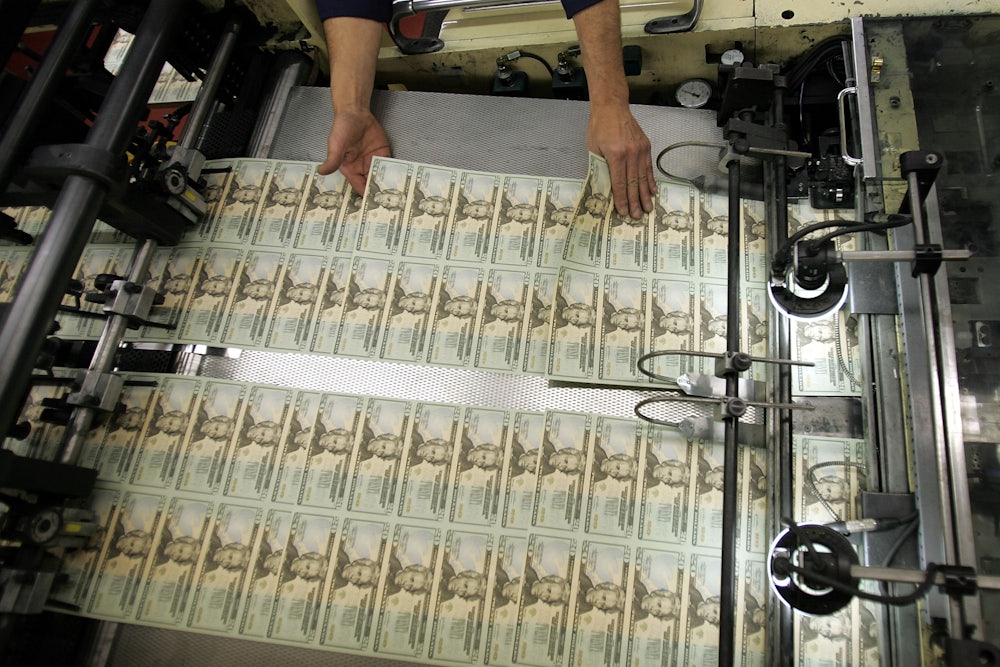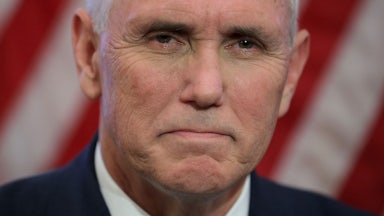Depending on which climate advocate you talk to, economic growth can either be the force that will deliver us from planetary destruction or the source of it. Most climate models assume growth is a given, projecting its bounties will eventually spur on decarbonization. But this risky gamble isn’t our only option, a new paper argues.
The International Panel on Climate Change serves as a clearinghouse for existing climate research. Its Special Report outlining ways to cap warming at 1.5 degrees Celsius (2.7 degrees Fahrenheit) includes 222 scenarios for the world to meet that target and avoid disaster. All of those, researchers Lorenz Keyßer and Manfred Lenzen note in a paper published in Nature Communications this week, involve steadily expanding economic growth. But “degrowth” options—where economic output declines—hold “a potential to avoid some of the key risks established in the normal scenarios,” Keyßer told me over Zoom. “This doesn’t mean we think degrowth is the most feasible option or that we must go this way. It’s just saying that we haven’t actually considered this way at all.”
The reason a degrowth future could be less risky, climate-wise, is pretty straightforward: The U.N. Environment Program’s 2020 Emissions Gap Report finds that carbon emissions will need to decrease by 7 percent worldwide every year through 2030 in order to cap warming at 1.5 degrees Celsius, which economic growth makes more difficult each year by adding to the stock of things that need to be decarbonized. Globally, economic growth and emissions are still linked.
Degrowth, a concept developed by ecological economists, doesn’t aim to ratchet down economic growth directly or enforce economic misery on the masses. Focusing specifically on richer countries, Keyßer explained, degrowth instead outlines “an equitable reduction in energy and material use, which is coupled to maintaining well-being.” Reduced GDP is a likely consequence of these priorities but not the goal. For example, things like widely provisioned care work and ecological restoration in the United States aren’t likely to spur rapid growth in the way that a manufacturing revival would here. Investments in childcare can have plenty of knock-on benefits for productivity and growth, as feminist economists have long pointed out. But a society that embraces the reality of long-term trends toward the service sector—and prioritizes widespread well-being over corporate profits—likely isn’t one that will “grow” (according to standard economic indicators) at the booming pace that defined the midcentury heyday of factory production.
The idea, degrowth advocates say, is for wealthier countries to make space in the carbon budget for development elsewhere, in recognition of the fact that development for now remains a carbon-intensive process. Keyßer and Lenzen’s paper outlines a gradual convergence of consumption habits that decline in wealthy nations and grow in poorer ones. That doesn’t entail a degraded quality of life in places like the U.S. but rather distributing the abundance of wealth here more equitably.
“By de-enclosing and expanding the commons, and by redistributing existing income more fairly,” anthropologist Jason Hickel has written, “we can enable people to access the goods that they need to live well without needing high levels of income (and therefore additional growth) in order to do so. People would be able to work less without any loss to their quality of life, thus producing less unnecessary stuff and therefore generating less pressure for unnecessary consumption.” Transitioning to such a society, Keyßer and Lenzen write, would entail “deep socioeconomic changes and policy reforms, such as universal basic services, maximum incomes, working time reductions, and democratic firm ownership.”
Some economists and climate advocates argue that “green growth” could finally sever the stubborn link between GDP growth and greenhouse gas emissions. This would allow for an environmentally sustainable growth that doesn’t fuel the climate crisis, swapping out the fossil fuels that currently power it for clean energy while increasing energy efficiency. There is scant empirical evidence that green growth is possible, Keyßer and Lenzen point out. There is evidence that some countries have experienced a potential step toward it known as “absolute decoupling,” where growth continues as carbon emissions decline, including those emissions embodied in trade (i.e., the carbon costs of imports). But it’s not happening fast enough or in enough places to inspire much confidence. As a recent Breakthrough Institute report notes, those countries that have experienced absolute decoupling are mostly wealthy countries, with economies that revolve around lower-carbon information technology and service sectors. So far, researchers say they have found “relatively few examples of low- or middle-income countries with a focus on energy-intensive manufacturing experiencing absolute decoupling.”
What often gets left out of often tense debates between degrowthers and green growthers is the fact that growth is slowing down for other reasons. Since the 1970s, poor and rich countries alike have experienced worsening economic stagnation, defined by low rates of business investment, economic growth, and job creation. The industrialization that powered rapid growth in the past has sputtered out, with nothing on offer to replace it. And while just about every country on earth continues to chase growth as the pathway to prosperity, these long-standing trends, historian Aaron Benanav has written, mean that “restoring previously prevailing rates of economic growth will prove difficult if not impossible.” Slowing rates of GDP growth have not cured the planet, of course—and have played out on terms set by capital feed profits. Yet the sorts of policies on offer from degrowth advocates—like universal basic services and shorter working hours—could help address some of the long-standing ills now afflicting a wide range of economies. Rather than chasing an increasingly far-off goal by trying to coax forth elusive corporate investment with giveaways, governments could start planning for what a fairer lower growth, lower carbon future might look like.
Instead, conventional climate modeling treats growth as a primary engine for decarbonization. Assumptions baked into many of the models compiled by the International Panel on Climate Change contend that making the world richer will bring down the cost of new technologies over time, so that by around 2050 they can be deployed at a massive scale. Essentially, models project that cheap new efficient green technology will come online to either replace or clean up the mess of old technology—think coal plants—and thus reduce the emissions intensity of rising demand. That’s a big risk considering how protean that technology still is. And more often than not, in those same models, Keyßer says, “reducing consumption is just not an option.” Rather than mapping out potential reductions in demand, that is, they tend to satisfy ever-growing demand in greener ways.
Simply meeting ballooning energy demand entirely with solar and wind would create its own set of problems. “Large-scale renewable energy deployment is unlikely to contribute to material use reduction, as renewables have a considerably higher material footprint than fossil fuels,” Keyßer and Lenzen write. Green energy is already helping fuel a global commodity boom and could in short order lead to shortages of minerals like lithium and cobalt. These are essential to electric vehicle production and currently mined in less than ideal circumstances. Besides investing inordinate faith in new technologies, a narrow focus on decarbonizing while maintaining consumption (and growth) as usual doesn’t address the broader ecological crises, such as biodiversity loss being fueled by ramped-up material usage.
Keyßer and Lenzen’s paper isn’t suggesting any draconian measures for slowing growth. “A precautionary approach would suggest degrowth should be considered, and debated, at least as seriously as risky technology-driven pathways upon which the conventional climate policies have relied,” Lenzen has said. Their paper puts options on the table that—bizarrely—have been mostly left off so far. The question now is whether either climate modelers or policymakers will be open to picking any of them up.








